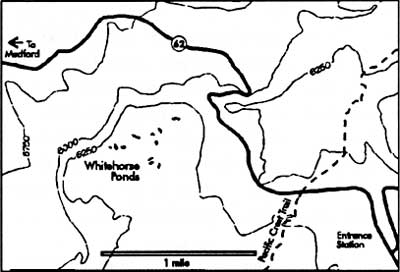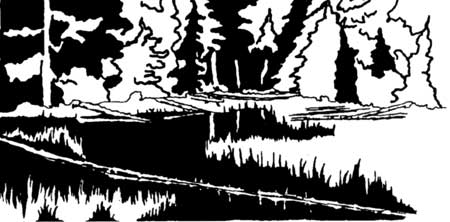Whitehorse Ponds: A Special Aquatic Study
A short hike from the junction of the Pacific Crest Trail and Highway 62 can take you to the top of Whitehorse Bluff. It can be reached by a relatively easy crosscountry walk and a short climb. The top of the bluff is at 6,200 feet in elevation and a world apart from surrounding areas below it. Hiking across the bluff will also lead you to encounter the setting of forest ponds. Atop Whitehorse Bluff are sixteen ponds, each with its unique inhabitants. During the summer of 1993, I along with David Hartlesveldt and Robert Truitt, received funding from the Crater Lake Natural History Association to survey Whitehorse Ponds. This survey included the biotic, physical, and chemical nature of these ponds.
A reconnaissance of the park’s forest ponds by Roger Brandt in 1992 (see pp. 12-13 of the 1993 Nature Notes from Crater Lake) served as the precursor to this survey. In visiting the Whitehorse Ponds five times in 1993, our investigation gathered data on the phytoplankton, zooplankton, vascular plants, water chemistry, and other pond inhabitants. Samples were collected with zooplankton nets, Van Dorn water samplers, and special nutrient bottles for chemical analyses. Instruments were deployed to measure in situ temperatures, pH, and conductivity. We also analyzed samples for plankton and chemical concentrations.
The authors made their first visit to the ponds on July 14,1993, when they found the area to be teeming with life. The drone of mosquitoes filled the air, while snow melted directly into the ponds. Even with the wet winter season and all the snow, the ponds were about 30 cm below capacity. This may suggest that water levels had not fully recovered from several prior years of dry weather.
Even so, the ponds were found to support healthy populations of dragon flies, water striders and other aquatic insects, frogs, toads, salamanders, moss and other aquatic plants, as well as many types of plankton.
Part of the survey involved comparing the ponds with the waters of Crater Lake, the springs which enter the lake from inside the caldera, and precipitation such as rain and snow. As a result, we found the amount of phosphorus, sodium, potassium, calcium, magnesium, and chloride ion concentrations in these ponds to be similar to precipitation, but very different from the lake and springs.
We also discovered that levels of two nutrients, sulfate and nitrate, in the ponds were far below levels in precipitation and in lake water. This suggests that vascular plants and phytoplankton in the ponds are quickly assimilating these nutrients as they become available from snow melt, rainfall, or through seepage from ground water. Crater Lake has been documented to be nitrate limited, meaning that the lack of nitrate is probably a key factor in limiting plant growth. The relative scarcity of nitrate ions in the ponds may similarly retard plant growth in these habitats.
Other chemical tests conducted include dissolved oxygen, pH, conductivity, and alkalinity. These estimate oxygen concentration, the acid/base level, total salt content, and the ability of water to neutralize acids, respectively. Conductivity data suggest these ponds are mostly rainwater supported with a few added ions from the soil. Alkalinity measurements reinforce the contention that the lake is fed by waters other than just rain or surface snowmelt. Measurements of alkalinity also show that the ponds have little ability to buffer additions of acid. This means that the ponds will most likely be affected if acid rain enters the pond complex.
Since the ponds appear to be fed solely by direct or indirect precipitation, change in the chemistry of the entering precipitation could likely affect their delicate balance. One threat may be from the burning of fossil fuels, which produces carbon, nitrogen, and sulfur oxides. These gases ultimately become carbonic acid, nitric acid, and sulfuric acid, which when combined with precipitation, can lower the pH of surface waters. This anthropogenic input could be a major agent of change for the ponds and lakes throughout the Cascade Range in the coming years.
The ponds were inhabited by several species of phytoplankton and their concentrations varied depending on the time of year. They include three species of Chrysophyta, two species of Chlorophyta, Cryptophyta, Cyanobacteria, and one species of Euglenophyta and Bacilariophyta. During one August visit, one pond sampled for phytoplankton contained mostly cyanobacteria. In another pond on the same day, more than half the phytoplankton sampled were cysts of a Chrysophyta. On a September visit, one phytoplankton sample contained more than 80 percent of one Chlorophyta species.
Identified zooplankton included eight species of Rotifers (a class of microscopic animals found only in fresh water whose anterior cilia give the appearance of rapidly revolving wheels when in motion) and three species of Cladorcerans (water fleas). There were also two species each of calanoid copepodes and cyclopoid copepodes. These orders often occur together, but usually feed on different material. We also found one fairy shrimp species. This virtually defenseless organism is often discovered in temporary ponds and is rarely present in ponds with carnivorous insects or fish. In terms of numbers, the most dominate zooplankton was Diaphanosoma brachyurum (a cladoceran), while the seed shrimp, Hexarthra mira, was the least abundant.
The ponds had a greater zooplankton diversity in early summer, but a greater number of individuals represented fewer species by fall. This suggests that autumn’s stressful conditions helped select species which take advantage of greater light intensity and higher water temperatures.
In small and remote places are found pockets of life’s communities. The sun, water, and nutrients of the Whitehorse Pond complex create one such niche. Simply walking to one of these ponds to experience helps one to appreciate life on earth because biotic tenacity is so well demonstrated here. By looking under the surface of a pond one finds a web of conditions which allow its inhabitants to survive. Dissolved nutrients support the ponds’ green plants, while algae support the ponds’ small animals.
Whitehorse Bluff presents scientists and visitors alike with a unique opportunity to study and appreciate a little known, but important, resource in Crater Lake National Park. The data collected in 1993 will provide background or baseline information, thereby securing a chemical and biological setting for the ponds in time. Future surveys will be able to compare data, thus allowing for trend analysis. These trends will help provide managers with better information on how to manage the pond, stream, and lake environments in and around Crater Lake National Park.
John Salinas is a former seasonal employee at Crater Lake. He teaches chemistry and physics at Rogue Community College in Grants Pass, Oregon.



